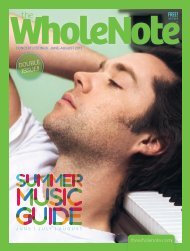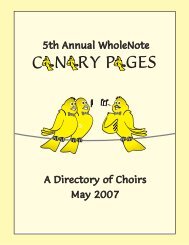September 2009 - The Wholenote Magazine
September 2009 - The Wholenote Magazine
September 2009 - The Wholenote Magazine
- No tags were found...
You also want an ePaper? Increase the reach of your titles
YUMPU automatically turns print PDFs into web optimized ePapers that Google loves.
Grieg - Sonata; Lyrical Pieces;Holberg SuiteDerek Yaple-SchobertXXI XXI-CD 2 1604Claude Debussy once referred to the pianomusic of Edvard Grieg as “pink bon bonsfilled with snow.” Today this seems an unkinddescription, for generations of pianistshave delighted in these small gems (myselfincluded), and rightly so – Grieg was a suprememiniaturist, easily capturing a widerange of moods on a small canvas.This newCD featuringpianist DerekYaple-Schoberton the XXIlabel, is a delight,and offersa thoughtfully-chosenprogram ofGrieg’s pianomusic, rangingfrom the familiar to the less well-known.A native of Montreal, Yaple-Schobert (whobears an eerie physical resemblance to theyoung Grieg himself) has long had an affinitywith music by Nordic composers, havingstudied in both Denmark and Sweden. Here,he opens not with one of the small pieces,but with Grieg’s Sonata in E minor, an earlywork from 1865. <strong>The</strong> playing is confidentand boldly self-assured, as befits the impassionedmood of the music. More lyrical – andcertainly more familiar – are Shepherd Boyand Notturno from the Six Lyrical PiecesOp.54 (the entire set is included) whichYaple-Schobert treats with great finesse. Bycontrast, the March of the Trolls, a quickpacedrustic dance with its ostinato rhythmsprovides him an opportunity to demonstratean impressive technique.One of Grieg’s most familiar and popularpieces, the Holberg Suite has been heard sooften in its version for string orchestra thatwe tend to forget that it originally began as asolo piano piece. In Yaple-Schobert’s capablehands, the neo-Baroque spirit comes throughadmirably, and from the beginning, he hasno trouble in convincing us that this music isas well suited to the solo keyboard as it is toa string orchestra. So I would say gratulerer(congratulations) to Mr. Yaple-Schobert on afine recording. Bon bons filled with snow? Ithink not!Richard Haskellmake these two an interesting pairing is nottheir supposed similarities but their clear andcontrasting differences.Each is represented by a sonata for violinand piano - No.2 of Schumann, No.1 of Bartok- and a solowork - Bartok’ssolo violin sonatafor Kremerand Schumann’sKinderszenenfor Argerich.<strong>The</strong> duoworks could notbe more differentin sound orstyle, with Schumann’s conservative approachtreating the somewhat subdued violin as partof the overall texture, while Bartok treats thetwo instruments independently, making greattechnical demands of the players. Kremerand Argerich have been performing togetherfor many years (they recorded the Schumannsonatas for DGG in 1986) and it shows - theyclearly think and feel as one.<strong>The</strong> solo works, too, are simply light yearsapart. Both receive outstanding performanceshere, but Kremer’s stunning playing in the fiendishlydifficult Bartok really steals the show.Audience presence is apparent before andafter each work, but thankfully never for amoment during the performances.Two Kreisler encores, Liebeslied and SchonRosmarin, round out this attractively-priced set.Terry RobbinsFrench Flute Chamber MusicMirage QuintetNaxos 8.570444for the harp; it’s true chamber music, with asophisticated interplay of instrumental forces.I particularly like the way the Mirage playersdig into the final movement’s big, emphaticchords with an expansive sweep.Similarly, Florent Schmitt’s Suite en rocailleOp. 84 is an elegant work – althoughthere’s an edgy urgency in the second andfourth movements. And Gabriel Pierné’sVariations libres et finale derives an archaicquality from the composer’s use of the Lydianmode. Jean Françaix’s Quintette is acharming piece; and so is Roussel’s SérénadeOp. 30, although its instrumental effects andharmonic leanings also give it a quirky, modernistquality.This isn’t the deepest music ever written –it’s a little too suave to be profound. But it isenjoyable, and very well performed.Colin EatockMODERN ANDCONTEMPORARYStravinsky and the Ballet Russes -<strong>The</strong> Firebird; <strong>The</strong> Rite of Spring<strong>The</strong> Mariinsky Orchestra and Ballet;Valery GergievBelAir classiques DVD BAC041This is an outstanding and important documentof an historic event. <strong>The</strong> celebrated riotthat occurred on the 6th of May, 1913 duringthe first performance of the new ballet,Le Sacre du Printemps was the expressionby the outraged audience at being assaultedvisually and aurally by Sergei Diaghilev andhis Ballets Russes. A year earlier Diaghilevhad delighted them with a work commissionedfrom Ravel,Daphnis et Chloë,choreographed byMichel Fokine. EarlierVaslav Nijinskyhad caused a minorriot with his languid,homo-erotic visionof Debussy’s Preludeà l’apres-midid’un faune, whichhe was obliged tosecretly choreographin his room. But LeSacre was something new, unheard of andunexpected in every respect. Pounding andbrutal rhythms with rapid time changes drovethe dancers to unrefined movements and inelegantposes. In a complete reversal of theusual order of things, Le Sacre began withthe music for which a storyline had to be devised.It became the rites of an ancient Slavictribe attempting to alter their destiny. <strong>The</strong>night of May 6, 1913 was the beginning ofthe end of Le Belle Epoch. WW1 didn’t help.If you buy this DVD, as you really should,be sure to watch and absorb the bonusfeatures, including an interview with arthistorian Kenneth Archer and MillicentDodson whose re-construction of Nijinsky’sI’m not sure how “real” the Mirage Quintetis – a quick Google of the name reveals noreferences to concerts performed anywhere,and the ensemble’s discography seems to consistentirely of this recording.But never mind. Even if the group is just amirage, its playersare all finemusicians: Canada’sreigningflutist, RobertAitken; leadingstudio musicianand Aitken’slong-time recitalpartner, harpistErica Goodman;violinist Jacques Israelievitch, recently retiredas concertmaster of the Toronto Symphony<strong>The</strong> Berlin RecitalOrchestra; and violist Teng Li and cellistGidon Kremer; Martha ArgerichWinona Zelenka, both current principals ofEMI Classics 6 93999 2that orchestra.<strong>The</strong> first thing that strikes you about this 2CD<strong>The</strong> music is also quite fine: several worksset, recorded in concert at the Berlin Philharmoniein December 2006, is the obvious dis-are thoroughly impressionistic in style, othersare touched with neo-classicism, but allparity between the two featured composers,are very French. CD collectors shouldn’t beSchumann and Bartok. <strong>The</strong> links suggesteddiscouraged if some of the early 20th-centuryin the booklet notes - two pianist-composerscompositions recorded here are unfamiliar.who wrote for every musical genre and wereMarcel Tournier was himself a harpist, asboth interested in musical education - are unconvincingand tenuous at best, but what doeshis lush writing for the instrument suggests.But his Op.34 Suite isn’t just a showpiece<strong>September</strong> 1 - October 7, <strong>2009</strong> WWW.THEWHOLENOTE.COM 51
















